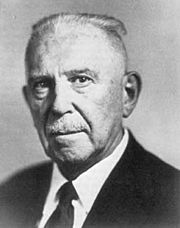Solomon Lefschetz facts for kids
Quick facts for kids
Solomon Lefschetz
|
|
|---|---|
 |
|
| Born | 3 September 1884 |
| Died | 5 October 1972 (aged 88) |
| Citizenship | US |
| Alma mater | École Centrale Paris Clark University |
| Known for | Lefschetz fixed-point theorem Picard–Lefschetz theory Lefschetz connection Lefschetz hyperplane theorem Lefschetz duality Lefschetz manifold Lefschetz number Lefschetz principle Lefschetz zeta function Lefschetz pencil Lefschetz theorem on (1,1)-classes |
| Awards | Bôcher Memorial Prize (1924) National Medal of Science (1964) Leroy P. Steele Prize (1970) Fellow of the Royal Society |
| Scientific career | |
| Fields | Algebraic topology |
| Institutions | |
| Thesis | On the Existence of Loci with Given Singularities (1911) |
| Doctoral advisor | William Edward Story |
| Doctoral students | Edward Begle Richard Bellman Felix Browder Clifford Dowker George F. D. Duff Ralph Fox Ralph Gomory John McCarthy Robert Prim Paul A. Smith Norman Steenrod Arthur Harold Stone Clifford Truesdell Albert W. Tucker John Tukey Henry Wallman Shaun Wylie |
| Other notable students | Sylvia de Neymet |
Solomon Lefschetz (born September 3, 1884 – died October 5, 1972) was a very important mathematician. He was born in Russia but became an American citizen. He made big discoveries in areas of math like algebraic topology and algebraic geometry. He also worked on how non-linear ordinary differential equations behave.
Contents
The Life of Solomon Lefschetz
Early Life and Challenges
Solomon Lefschetz was born in Moscow, Russia. His parents were traders who traveled a lot. They had Ottoman passports. Soon after he was born, his family moved to Paris, France.
He studied engineering at the École Centrale Paris in France. In 1905, he moved to the United States. In 1907, he had a serious accident at work. He lost both of his hands. This event changed his life path.
A New Path in Math
After his accident, Solomon decided to focus on mathematics. He earned his Ph.D. (a high-level university degree) in algebraic geometry in 1911. He got this degree from Clark University in Massachusetts.
He then worked at the University of Nebraska and the University of Kansas. In 1924, he moved to Princeton University. He quickly got a permanent job there. He stayed at Princeton until 1953.
Important Discoveries in Math
Solomon Lefschetz was very interested in how topology could be used in algebraic geometry. Topology is a part of math that studies shapes and spaces. Algebraic geometry uses algebra to study geometric shapes.
He proved important theorems about how shapes change when you slice them. One of his most famous ideas is the Lefschetz fixed-point theorem. This theorem helps mathematicians understand when a point stays in the same place after a shape is moved or transformed. He developed this idea between 1923 and 1927.
In 1924, he wrote a very important book called L'analysis situs et la géométrie algébrique. This book helped shape the future of homology theory, which is a way to study holes in shapes. His work was so good that he won the Bôcher Memorial Prize in 1924. He was also chosen to be part of the United States National Academy of Sciences in 1925.
His work on topology was summarized in his book Algebraic Topology in 1942. Later, starting in 1944, he began to work on differential equations. These are equations that involve rates of change.
Helping Math Grow
Solomon Lefschetz was the editor of a very important math journal called the Annals of Mathematics. He was the editor from 1928 to 1958. During this time, the Annals became one of the most respected math journals in the world. He played a big part in its success.
In 1945, he started visiting Mexico. He worked as a visiting professor at the National University of Mexico. He visited Mexico often and spent many winters there from 1953 to 1966. He helped a lot with the development of mathematics in Mexico. He encouraged many Mexican students to study at Princeton.
Even after he retired in 1958, he continued to work. This was partly because of the launch of Sputnik, which made the U.S. want to improve its science and math. He joined the Glenn L. Martin Company's Research Institute for Advanced Studies (RIAS). There, he led a large group of mathematicians studying nonlinear differential equations. This group helped this area of math grow a lot.
In 1964, he left RIAS to start the Lefschetz Center for Dynamical Systems at Brown University. He continued to influence the world of mathematics throughout his life.
Selected Works
Here are some of the important books and papers Solomon Lefschetz wrote:
- L´Analysis situs et la géométrie algébrique, 1924
- Topology, 1930
- Algebraic Topology, 1942
- Introduction to topology, 1949
- Algebraic geometry, 1953
- Differential equations: geometric theory, 1957

